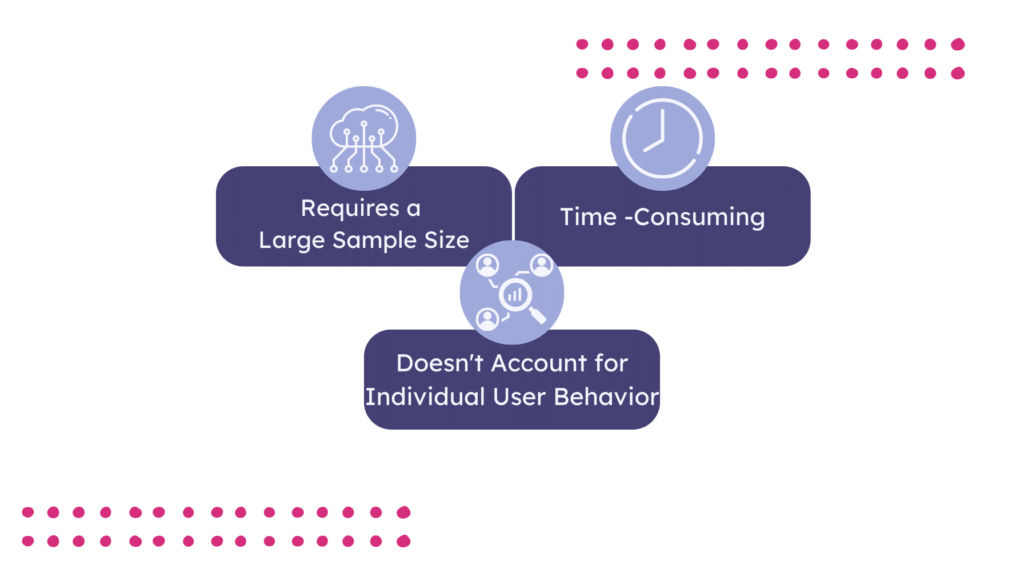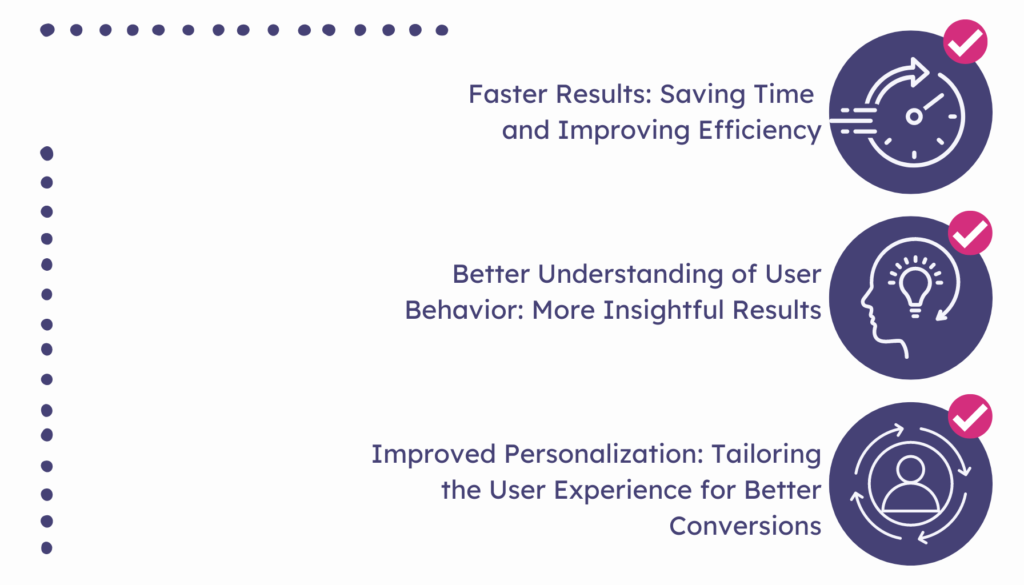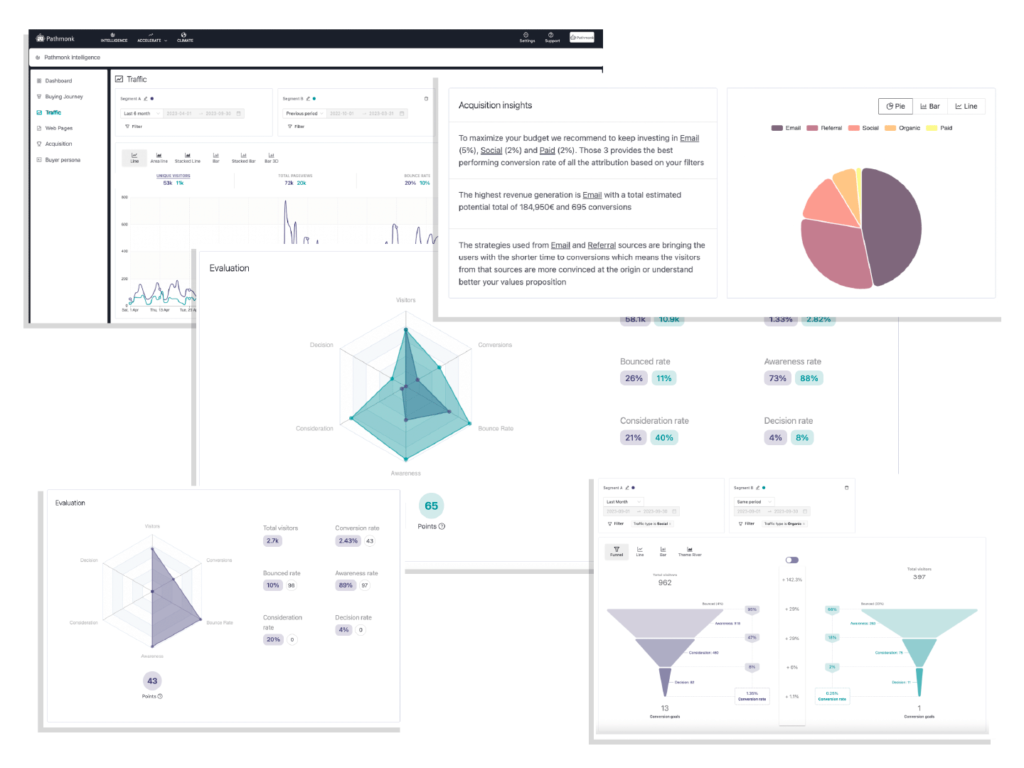
Conversion rate optimization (CRO) is an essential practice that enables businesses to improve the performance of their websites and increase the likelihood of converting visitors into customers. A/B testing, in particular, has been a go-to method for CRO professionals for years, allowing them to test different variations of web pages and determine which one is more effective at driving conversions. However, as we enter 2023, it’s becoming increasingly clear that A/B testing may no longer be enough to keep up with the demands of modern marketing.
In this series of blog posts, we’ll dive into understanding why CRO trends, like A/B testing, traditional landing pages, and pop-ups or overlays are dying. Here, we’ll explore the limitations of A/B testing and examine alternative methods that are gaining traction in the world of CRO. We’ll look at multivariate testing, which allows businesses to test multiple variables simultaneously, personalization testing, which tailors the user experience based on individual preferences, and predictive analytics, which uses data to make informed decisions about which variations to test. We’ll also discuss the importance of choosing the right testing method for your business and the role of data analysis in selecting the most effective approach.
The Limitations of A/B Testing: Why A/B Testing is No Longer Enough
A/B testing has been a cornerstone of CRO for years, allowing us to test different variations of web pages and determine which one is more effective at driving conversions. However, A/B testing has several limitations that make it less effective in the current landscape of digital marketing. We’ll examine the key limitations of A/B testing and why it’s no longer enough to keep up with the demands of modern marketing.
A/B Testing Requires a Large Sample Size
One of the biggest limitations of A/B testing is that it requires a large sample size to generate statistically significant results. This means that you must wait until you have enough traffic to your website before you can even begin testing, and even then, you may need to wait for weeks or even months to collect enough data. In the fast-paced world of digital marketing, waiting for results this long can be detrimental to your success and you can quickly fall behind in a very competitive landscape.
A/B Testing is Time-Consuming
In addition to the time required to collect data, A/B testing also involves creating and implementing multiple variations of a web page, which can be a complex and time-consuming process. This means that you must invest a significant amount of time and resources into A/B testing, which may not be feasible for smaller companies or those with limited budgets.
A/B Testing Doesn't Account for Individual User Behavior
Every user is unique, and their behavior on a website can vary widely. A/B testing treats all users as if they have the same preferences and needs, which can lead to inaccurate results. In today’s world, where personalization is becoming increasingly important in digital marketing, this limitation of A/B testing can be a significant hurdle.

Alternative Methods for Testing and Improving Conversion Rates
A/B testing has been a valuable tool for improving conversion rates, but there are now alternative methods that are gaining traction in the world of CRO. Let’s dive into three of these methods: multivariate testing, personalization testing, and predictive analytics.
Multivariate Testing: A More Efficient Way to Test Multiple Variables
Multivariate testing is a more efficient way to test multiple variables than A/B testing. Rather than testing just two variations of a web page, multivariate testing, as the name suggests, allows you to test multiple variations of multiple elements on a page, all at once. This means that you can collect data on a larger number of variables in a shorter amount of time, which can be particularly useful for websites with a large amount of traffic.
One of the key advantages of multivariate testing over A/B testing is that you’ll be able to identify the most effective combination of variables, rather than just the most effective variation of a single variable. For example, if a business wants to test the headline, image, and call-to-action on a web page, multivariate testing would allow them to test all possible combinations of those three elements. This can lead to more nuanced insights about what combinations of variables work best together, rather than just which single variation of a single variable is most effective.
There are many examples of businesses that have successfully used multivariate testing to improve their conversion rates. For example, Expedia used multivariate testing to optimize its flight booking process, resulting in a 12% increase in bookings. Another example is Obama for America, which used multivariate testing to optimize its donation page, resulting in a 49% increase in conversions
Personalization Testing: Customizing the User Experience for Better Results
Personalization testing involves customizing the user experience based on data about the user, such as their intent, browsing behavior, or purchase history. This can involve showing different content or offers to different users, or even customizing the layout of a page based on the user’s preferences.
Increase +180%
leads
demos
sales
bookings
from your website with AI
Get more results from your existing website traffic delivering personalized experiences at every stage of your customer journey.
One of the advantages of personalization testing over A/B testing is that you can create a more tailored experience for your users. Customizing the user experience based on data will result in a more engaging and personalized experience that is more likely to drive conversions. Personalization testing can help you improve customer loyalty and retention, as users are more likely to return to a website that provides a customized experience.
There are many examples of businesses that have successfully used personalization testing to improve their conversion rates. For example, Amazon uses personalization to recommend products to users based on their browsing and purchase history, resulting in increased sales. While Netflix uses personalization to recommend movies and TV shows to users based on their viewing history, resulting in increased engagement and retention.
Predictive Analytics: Using Data to Make Informed Decisions
Predictive analytics involves using data to make informed decisions about what changes to make to a web page to improve conversion rates. This can include analyzing data about user behavior, such as which pages they visit or how long they stay on a page, to predict which changes are likely to be most effective.
One of the advantages of predictive analytics over A/B testing is that it can provide more accurate and actionable insights. By analyzing large amounts of data, you can identify patterns and trends that may not be apparent with A/B testing alone. Predictive analytics can also help you make more informed decisions about what changes to make to a web page, rather than relying on trial and error.
There are many examples of businesses that have successfully used predictive analytics to improve their conversion rates. For example, Booking.com uses predictive analytics to personalize its website based on data about the user’s search history and booking behavior, resulting in increased bookings. By analyzing user data and using machine learning algorithms, Amazon is able to personalize the user experience and make product recommendations based on each user’s past behavior. This has led to increased conversion rates and revenue for the company.
The Benefits of Alternative Methods
If you’re still relying solely on A/B testing to improve your conversion rates, you may miss out on the benefits of more advanced testing methods. Here are just a few reasons why you should consider exploring alternative methods:
Faster Results: Saving Time and Improving Efficiency
One of the biggest advantages of alternative methods for CRO is that they can deliver results faster than traditional A/B testing. Multivariate testing will result in faster and more efficient testing as you test multiple variables at once. While predictive analytics uses data to make informed decisions about what elements to test and how to personalize the user experience.
Better Understanding of User Behavior: More Insightful Results
Through personalization testing you’ll gain a deeper understanding of user behavior and preferences, which can inform future testing and optimization efforts. This will create a unique experience for each user based on their behavior, preferences, and past interactions with your website.
Multivariate testing offers more insightful results than A/B testing, as you test multiple variables simultaneously. This can provide a complete picture of how users interact with your website and provide insight into which elements have the greatest impact on conversion rates.

Improved Personalization: Tailoring the User Experience for Better Conversions
Improving personalization will result in more conversions, we even have proof. Personalization testing will allow you to create a unique experience for each user, which can lead to increased engagement and conversion rates. Predictive analytics will also result in personalization, as it uses data to make informed decisions about how to personalize the user experience and which products or services to recommend to each user.
Choosing the Right Testing Method for Your Business
While A/B testing has been the gold standard for years, it’s becoming increasingly clear that it’s not always the best choice for every business. When it comes to improving conversion rates, it’s important to choose the right testing method that works best for your specific business needs.
Different businesses have different goals, customer segments, and user behavior patterns, so it’s crucial to consider these factors when selecting a testing method. For example, a business that caters to a highly specific niche audience may benefit more from personalization testing, whereas a business with a broader audience may see better results from multivariate testing.
Data analysis plays a critical role in selecting the most effective testing approach. By analyzing user behavior data, you can gain insight into how your customers interact with your website, what drives them to make a purchase, and what obstacles may be preventing them from converting. This information can help you identify the areas of your website that need improvement and guide your testing strategy.
Intuitive Cookieless Analytics for Your Web
Understand your customer journey, find drop-offs, and receive actionable insights with AI.

Ultimately, the key is to choose a testing method that aligns with your business goals and provides the most impactful results. By selecting the right testing method and utilizing data analysis, you can optimize your website and drive more conversions, leading to greater business success.
Conclusion
With the rise of new technologies and testing methods, you have more options than ever before to improve your website’s performance and drive more conversions.
By exploring alternative testing methods like multivariate testing, personalization testing, and predictive analytics, you can gain faster results, better understand user behavior, and improve personalization for better conversions. It’s important that you choose the right testing method that aligns with your specific goals and customer segments, and to utilize data analysis to select the most effective approach.
As we move further into 2023, businesses that are able to adapt and embrace these new testing methods will have a significant competitive advantage. By staying up-to-date with the latest trends and technologies, you can optimize your website and provide a better user experience for your customers, leading to greater success in the digital marketplace.






